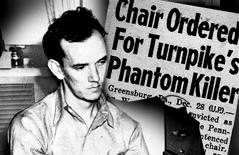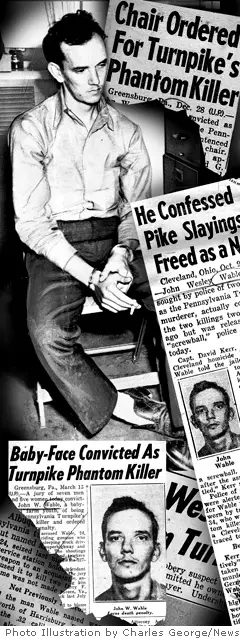Everyone did it, and it was something that Lester Woodward had probably done a hundred times before. On a foggy Saturday night, July 25, 1953, Woodward, 30, an interstate trucker, pulled his rig off the Pennsylvania Turnpike and into an unlit parking lot to catch a few hours of shuteye.
That isolated patch of gravel would be the end of the road for him.
The next morning, another trucker got lost and found himself on the same out-of-the-way route. He pulled alongside Woodward's rig to ask directions.
Woodward was slumped in the cab, dead, a .32-caliber slug in his brain.
Police speculated that in the early morning, the killer had pulled his car up next to the truck, climbed up to the cab, and shot Woodward as he slept.
A six-car pileup, in which several people died, occurred around the same time, and it seemed likely that the gunman had caused the accident as he fled the scene at high speed.
Woodward's wallet was empty, and everyone assumed that robbery had been the motive.
Three days later, and 30 miles to the east, the killer struck again.
The victim was Harry Pitts, 39, a driver for the Baker Drive-Away Co. Like Woodward, he had pulled into an isolated gravel lot to sleep. The next morning, a fellow trucker recognized Pitts' rig and stopped to chat. But Pitts was in no condition for conversation. He had been killed around midnight, shot through the mouth with a .32.
Tire tracks suggested that the killer had screeched across the eastbound lanes and into the westbound lanes.
Ballistics confirmed that the same gun had killed both men.
'Circling the wagons'
Some truckers started to take precautions, arming themselves with clubs and firearms. They traveled with buddies, or formed convoys. When it was time to sleep, they swarmed into the parking lots of restaurants and service stations and joked about "circling the wagons."
Others, however, saw no danger. One told a reporter that the murders were probably the work of a man with a grudge.
"Maybe he got the wrong guy the first time and then went back to get the right one the second time," the trucker said.
Fear gripped the turnpike, and troopers patrolled the roads, waking all lone, slumbering drivers, sometimes telling them to move along, other times just to make sure they were not dead.
After another shooting, a day later and in Ohio, 18 miles past the western end of the turnpike, authorities proposed a different motivation.
"There is a maniac loose on the turnpike," a detective told reporters. The killer became known all over the country as "The Turnpike Phantom."
John Shepard, 36, was victim No. 3. Like the others, he had pulled off the road and closed his eyes. The difference was that Shepard lived to tell what happened next.
"Then a noise like a firecracker went off in my head. I reared up and yelled for mother. I thought I was at home," he said from his hospital bed a couple of days later, his mother, Agnes, by his side.
He had a bandage over his jaw. Miraculously, the bullet had done little damage.
Shepard said that after he felt the pain in his head, he heard a high-pitched male voice. The man said he was out of gas and needed money. Then he told Shepard to take off his pants. Shepard complied. His assailant snatched the pants, took Shepard's watch, then leaped into a car, and roared off.
The bullet taken from Shepard's jaw came from the gun that had killed Woodward and Pitts.
Police pulled in anyone who looked in the least suspicious in all the surrounding states. There was a recently married couple who had financed their cross-country hitchhiking honeymoon by stealing; a businessman with a .22-caliber automatic in his trunk; three toughs from Florida; and a carload of gang members from St. Louis.
All had alibis, or could not be connected to the shootings. Several truckers reported being followed by a man in a car, but he vanished before police could arrive.
For more than a month there was no progress, despite roadblocks and a multistate dragnet. Even an $11,000 reward offered by the Pennsylvania Truck Motor Association failed to bring any meaningful leads.
Then, in early October, Shepard's watch turned up in a Cleveland pawnshop. Police traced the man who had pawned it - John Wesley Wable - to a roominghouse in the same town. By the time cops arrived, the suspect had skipped out, leaving an unpaid rent bill and a baffled blond sweetheart, Leora Crissey, 22.
Crissey said that she had no idea why her boyfriend vanished. Even more peculiar was his going-away present - a pistol.
It was the same gun that had wounded Shepard and killed Woodward and Pitts.
A skinny 25-year-old, Wable was an unemployed factory worker who had been fired from his job in March. He had no record of violent crime, but had been arrested on Aug. 6, not far from the scene of the first murder, for failing to return a car that he had rented on July 18. Police held him in the county jail until Sept. 23, when Wable's father, an unemployed miner, settled the claim with the car dealer, and the case was dismissed.
Behind bars, Wable was unusually chatty, and blabbed about being the Turnpike Phantom. But police viewed his confession in the same light as dozens of others - the ravings of another crackpot. He was set free.
On Oct. 9, a nationwide manhunt for Wable began.
'I'm not guilty'
A day later a New Mexico state patrolman spotted a stolen car near Isleta, 10 miles south of Albuquerque. Inside were three men, wanted in a stickup of an Albuquerque gas station. Although New Mexico police did not know it at the time, Wable was one of the holdup men.
With cops on their tail, Wable and his sidekicks - J.D. Francis and Marvin Pierson - sped off at 100 mph, crashing through two roadblocks. By the time police caught up with the car, only Francis and Pierson were still inside. Wable had fled on foot.
A few hours later, an off-duty nurse, Carolyn Smith, and her friend Midge Harman, spotted a hitchhiker walking toward a local hobo jungle near the Santa Fe railroad track. On a hunch, Smith reported the sighting to police.
"I'm not guilty," Wable bellowed as the law closed in. Wable insisted that he had nothing to do with the murders. He admitted he owned the murder weapon, but said that a "man I've known a long time" named Jim Parks had borrowed the gun and had it at the time of the killings.
No one could find Parks, but Wable stuck to his story through his trial, which started on March 5, 1954. He admitted he had been at the scene when Shepard was shot, but said it was Parks who had pulled the trigger and stolen the watch.
Wable said that he bought the watch from Parks, then pawned it.
The prosecution's case was circumstantial, and Wable's father swore his boy was tucked in his bed, sound asleep, when one of the truckers was shot. But the verdict, after four hours deliberation, was, "Guilty. First degree. Death Penalty."
Wable died in the electric chair on Sept. 26, 1955, but he was not forgotten. The lone gunman forever changed the habits of interstate truckers, who learned that being encased in a steel behemoth offers no security against a maniac with a gun. They started avoiding secluded, dark places to sleep and instead crammed themselves into crowded, bright roadside rest stops before they would close their eyes.


